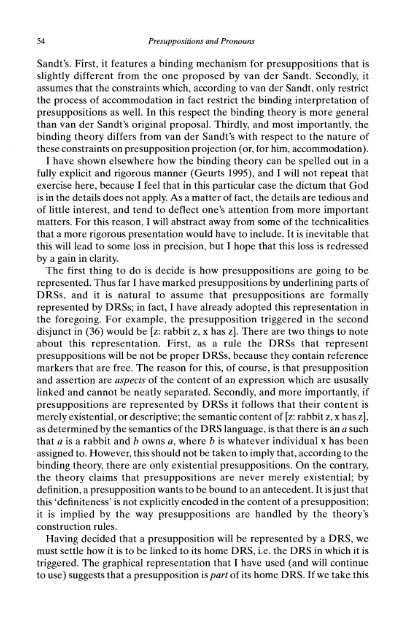Presuppositions and Pronouns - Nijmegen Centre for Semantics
Presuppositions and Pronouns - Nijmegen Centre for Semantics
Presuppositions and Pronouns - Nijmegen Centre for Semantics
Create successful ePaper yourself
Turn your PDF publications into a flip-book with our unique Google optimized e-Paper software.
54 <strong>Presuppositions</strong> <strong>and</strong> <strong>Pronouns</strong><br />
S<strong>and</strong>t's. First, it features a binding mechanism <strong>for</strong> presuppositions that is<br />
slightly different from the one proposed by van der S<strong>and</strong>t. Secondly, it<br />
assumes that the constraints which, according to van der S<strong>and</strong>t, only restrict<br />
the process of accommodation in fact restrict the binding interpretation of<br />
presuppositions as well. In this respect the binding theory is more general<br />
than van der S<strong>and</strong>t's original proposal. Thirdly, <strong>and</strong> most importantly, the<br />
binding theory differs from van der S<strong>and</strong>t's with respect to the nature of<br />
these constraints on presupposition projection (or, <strong>for</strong> him, accommodation).<br />
I have shown elsewhere how the binding theory can be spelled out in a<br />
fully explicit <strong>and</strong> rigorous manner (Geurts 1995), <strong>and</strong> I will not repeat that<br />
exercise here, because I feel that in this particular case the dictum that God<br />
is in the details does not apply. As a matter of fact, the details are tedious <strong>and</strong><br />
of little interest, <strong>and</strong> tend to deflect one's attention from more important<br />
matters. For this reason, I will abstract away from some of the technicalities<br />
that a more rigorous presentation would have to include. It is inevitable that<br />
this will lead to some loss in precision, but I hope that this loss is redressed<br />
by a gain in clarity.<br />
The first thing to do is decide is how presuppositions are going to be<br />
represented. Thus far I have marked presuppositions by underlining parts of<br />
DRSs, <strong>and</strong> it is natural to assume that presuppositions are <strong>for</strong>mally<br />
represented by DRSs; in fact, I have already adopted this representation in<br />
the <strong>for</strong>egoing. For example, the presupposition triggered in the second<br />
disjunct in (36) would be [z: rabbit z, x has z]. There are two things to note<br />
about this representation. First, as a rule the DRSs that represent<br />
presuppositions will be not be proper DRSs, because they contain reference<br />
markers that are free. The reason <strong>for</strong> this, of course, is that presupposition<br />
<strong>and</strong> assertion are aspects of the content of an expression which are ususally<br />
linked <strong>and</strong> cannot be neatly separated. Secondly, <strong>and</strong> more importantly, if<br />
presuppositions are represented by DRSs it follows that their content is<br />
merely existential, or descriptive; the semantic content of [z: rabbit z, x has z],<br />
as determined by the semantics of the DRS language, is that there is an a such<br />
that a is a rabbit <strong>and</strong> b owns a, where b is whatever individual x has been<br />
assigned to. However, this should not be taken to imply that, according to the<br />
binding theory, there are only existential presuppositions. On the contrary,<br />
the theory claims that presuppositions are never merely existential; by<br />
definition, a presupposition wants to be bound to an antecedent. It is just that<br />
this 'definiteness' 'defmiteness' is not explicitly encoded in the content of a presupposition;<br />
it is implied by the way presuppositions are h<strong>and</strong>led by the theory's<br />
construction rules.<br />
Having decided that a presupposition will be represented by a DRS, we<br />
must settle how it is to be linked to its home DRS, i.e. the DRS in which it is<br />
triggered. The graphical representation that I have used (<strong>and</strong> will continue<br />
to use) suggests that a presupposition is part of its home DRS. If we take this














